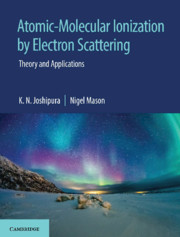Book contents
- Frontmatter
- Dedication
- Contents
- List of Figures
- List of Tables
- Foreword I
- Foreword II
- Preface
- Acknowledgments
- 1 Atoms and Molecules as Bound Quantum Systems
- 2 Quantum Scattering Theories
- 3 Electron Atom Scattering and Ionization
- 4 Electron Molecule Scattering and Ionization – I: Small Molecules and Radicals
- 5 Electron Molecule Scattering and Ionization – II: Other Polyatomic Molecules and Radicals
- 6 Applications of Electron Scattering
- Bibliography
- Index
Preface
Published online by Cambridge University Press: 20 December 2018
- Frontmatter
- Dedication
- Contents
- List of Figures
- List of Tables
- Foreword I
- Foreword II
- Preface
- Acknowledgments
- 1 Atoms and Molecules as Bound Quantum Systems
- 2 Quantum Scattering Theories
- 3 Electron Atom Scattering and Ionization
- 4 Electron Molecule Scattering and Ionization – I: Small Molecules and Radicals
- 5 Electron Molecule Scattering and Ionization – II: Other Polyatomic Molecules and Radicals
- 6 Applications of Electron Scattering
- Bibliography
- Index
Summary
Electrons are ubiquitous in nature and throughout modern industry, and therefore there are varieties of situations in which electrons interact with atoms and molecules producing diverse physical and chemical phenomena. Extensive studies, both experimental and theoretical, have been carried out on the interactions of electrons with different atomic and molecular targets; indeed the last few decades have witnessed rapid developments in the techniques and methodology for exploring electron–atom/molecule scattering. The wider recognition of the role of fundamental electron interactions in natural phenomena (for example, the observation of aurorae on other planets and the contribution of electron interactions in astrochemistry), in underpinning novel technologies such as Focussed Electron Beam Induced Deposition (FEBID), and as a major source of radiation damage by ionizing radiation has led to an increase in the size of the international community studying electron collisions in all phases of matter.
In this book, our aim is to provide an overview of the field with a focus on theoretical methods used to describe the collisions of intermediate to high energy (exceeding about 15 eV) electrons. The book has six chapters and begins with a discussion of the subject by outlining the necessary textbook background on atoms, molecules, and quantum scattering theories. Attention has been devoted (in Chapter 1) to atomic sizes or ‘radii’ – something that is normally missing in most books and reviews of this kind. A brief survey of atomic radii, running across the periodic table of elements, is outlined.
The major part of this monograph provides an up-to-date review of electron scattering from atoms and molecules, summarizing recent publications. Although the title of the present book mentions ionization specifically, the contents are comprehensive in that we highlight several important inelastic processes ocurring in the background of elastic scattering. For many atoms and a large number of molecules, recent theoretical results are discussed along with experimental and other data, and wherever possible recommended data are presented to provide the user with data sets for models and simulations of processes in which electron interactions play a significant role.
- Type
- Chapter
- Information
- Atomic-Molecular Ionization by Electron ScatteringTheory and Applications, pp. xxvii - xxxPublisher: Cambridge University PressPrint publication year: 2019

